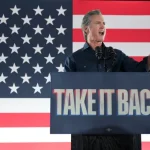Elon Musk has released the third installment of “The Twitter Files,” detailing the decision to ban former President Donald Trump after the Jan. 6, 2021 riot at the U.S. Capitol. Only a day after the company dropped the second installment related to the company’s content moderation practices, the company is now divulging the forces surrounding the decision to remove the former president from the platform.
Elon Musk has released the third installment of “The Twitter Files,” detailing the decision to ban former President Donald Trump after the Jan. 6, 2021 riot at the U.S. Capitol. Only a day after the company dropped the second installment related to the company’s content moderation practices, the company is now divulging the forces surrounding the decision to remove the former president from the platform.
4. This first installment covers the period before the election through January 6th. Tomorrow, @Shellenbergermd will detail the chaos inside Twitter on January 7th. On Sunday, @BariWeiss will reveal the secret internal communications from the key date of January 8th.
— Matt Taibbi (@mtaibbi) December 9, 2022
The journalist explains how Twitter executives “started processing new power” after they banned Trump and laid the groundwork for future decisions regarding the banning of presidents.” The employees said the Biden administration would “not be suspended by Twitter unless absolutely necessary.”
5. Whatever your opinion on the decision to remove Trump that day, the internal communications at Twitter between January 6th-January 8th have clear historical import. Even Twitter’s employees understood in the moment it was a landmark moment in the annals of speech. pic.twitter.com/tQ01n58XFc
— Matt Taibbi (@mtaibbi) December 9, 2022
Twitter executives said they removed Trump because of the “context surrounding” the actions of Trump and his supporters throughout the 2020 election season.
6. As soon as they finished banning Trump, Twitter execs started processing new power. They prepared to ban future presidents and White Houses – perhaps even Joe Biden. The “new administration,” says one exec, “will not be suspended by Twitter unless absolutely necessary.” pic.twitter.com/lr66YgDlGy
— Matt Taibbi (@mtaibbi) December 9, 2022
Prior to the riot, the company employed a more “subjective moderation” approach.
8. The bulk of the internal debate leading to Trump’s ban took place in those three January days. However, the intellectual framework was laid in the months preceding the Capitol riots.
— Matt Taibbi (@mtaibbi) December 9, 2022
Taibbi notes that after the riot, communications on Slack showed Twitter executives “getting a kick out of intensified relationships with federal agencies.”
The journalist goes on to discuss a Slack channel in which Twitter would converse about “election-related removals,” particularly related to “ accounts, which are called “VITs,” or “Very Important Tweeters.” He wrote:
On October 8th, 2020, executives opened a channel called “us2020_xfn_enforcement.” Through J6, this would be home for discussions about election-related removals, especially ones that involved “high-profile” accounts (often called “VITs” or “Very Important Tweeters”).
13. One particular slack channel offers an unique window into the evolving thinking of top officials in late 2020 and early 2021.
— Matt Taibbi (@mtaibbi) December 9, 2022
The smaller group consisting of former CEO Jack Dorsey, former head of legal, policy, and trust Vijaya Gadde, and former cybersecurity head Yoel Roth, were a “high-speed Supreme Court of moderation,” according to Taibbi. They made content moderation decisions “on the fly, often in minutes and based on guesses, gut calls, even Google searches, even in cases involving the President.”
It appears these individuals did not put much thought into decisions to ban, or otherwise punish, accounts tweeting views with which they disagreed.
16. The latter group were a high-speed Supreme Court of moderation, issuing content rulings on the fly, often in minutes and based on guesses, gut calls, even Google searches, even in cases involving the President. pic.twitter.com/5ihsPCVo62
— Matt Taibbi (@mtaibbi) December 9, 2022
Meanwhile, these executives were “clearly liasing” with federal agencies regarding the moderation of content related to the 2020 election.
16. The latter group were a high-speed Supreme Court of moderation, issuing content rulings on the fly, often in minutes and based on guesses, gut calls, even Google searches, even in cases involving the President. pic.twitter.com/5ihsPCVo62
— Matt Taibbi (@mtaibbi) December 9, 2022
In fact, Roth met weekly with officials from the FBI and DHS, and also the Office of the Director of National Intelligence (DNI).
This post about the Hunter Biden laptop situation shows that Roth not only met weekly with the FBI and DHS, but with the Office of the Director of National Intelligence (DNI):
19. Pickles quickly asks if they could “just say “partnerships.” After a pause, he says, “e.g. not sure we’d describe the FBI/DHS as experts.” pic.twitter.com/d3EaYJb5eR
— Matt Taibbi (@mtaibbi) December 9, 2022
In a report to these three agencies, Roth wrote:
We blocked the NYP story, then we unblocked it (but said the opposite) … and now we’re in a messy situation where our policy is in shambles, comms is angry, reporters think we’re idiots, and we’re refactoring an exceedingly complex policy 18 days out from the election.
20. This post about the Hunter Biden laptop situation shows that Roth not only met weekly with the FBI and DHS, but with the Office of the Director of National Intelligence (DNI): pic.twitter.com/s5IiUjQqIY
— Matt Taibbi (@mtaibbi) December 9, 2022
The FBI even sent Twitter reports highlighting certain tweets, one of which involved Indiana Councilor and Republican named John Basham in which he said: “Between 2% and 25% of Ballots by Mail are Being Rejected for Errors.”
23. Some of Roth’s later Slacks indicate his weekly confabs with federal law enforcement involved separate meetings. Here, he ghosts the FBI and DHS, respectively, to go first to an “Aspen Institute thing,” then take a call with Apple. pic.twitter.com/i771hD8aCD
— Matt Taibbi (@mtaibbi) December 9, 2022
Twitter decided that these tweets were “proven to be false” and that one of them was “no vio on numerous occasions.”
The FBI's second report concerned this tweet by @JohnBasham: pic.twitter.com/8J8j5GlUVx
— Matt Taibbi (@mtaibbi) December 10, 2022
What is also noteworthy is that the journalists did not “see one reference to moderation requests from the Trump campaign, the Trump White House, or Republicans generally.”
26. The group then decides to apply a “Learn how voting is safe and secure” label because one commenter says, “it’s totally normal to have a 2% error rate.” Roth then gives the final go-ahead to the process initiated by the FBI: pic.twitter.com/lyZm4gmT19
— Matt Taibbi (@mtaibbi) December 10, 2022
The company also prepared to put a “mail-in voting is safe” warning label on a tweet from Trump calling out a voting mishap in Ohio that involved mail-in ballots. They decided against it after realizing that “the events took place” which means the former president’s tweet was “factually accurate.”
34. In the docs, execs often expand criteria to subjective issues like intent (yes, a video is authentic, but why was it shown?), orientation (was a banned tweet shown to condemn, or support?), or reception (did a joke cause “confusion”?). This reflex will become key in J6.
— Matt Taibbi (@mtaibbi) December 10, 2022
Even more damning is that Trump was “visibility filtered” about a week before the election despite not appearing “to have a particular violation.” Employees worked quickly to ensure that any of Trump’s tweets could not be “replied to, shared, or liked.”
Taibbi indicated at the beginning of the thread that more drops would be coming on Saturday and Sunday further explaining the decision to ban Trump as well as other issues. Journalists Bari Weiss and Michael Shellenberger are expected to handle the next batch of information.
Story cited here.
























